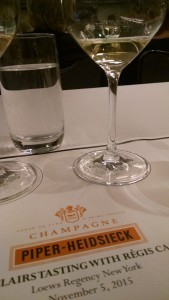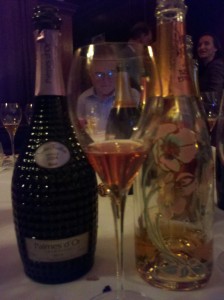Category Archives: Champagne
Pieces of the Puzzle: Putting Together a Glass of Champagne
 Once upon a time (also known as several years ago), we found a scrap of plastic film that read, “Assembly of Dust. Some Assembly Required.”
Once upon a time (also known as several years ago), we found a scrap of plastic film that read, “Assembly of Dust. Some Assembly Required.”
Not knowing what it was or what is meant, it was one of the strangest and most confusing things we ever found on our kitchen counter. After much scratching of our collective heads, we finally identified the scrap as having come from the wrapper of a music CD that a houseguest had opened earlier that day. (It turns out that Assembly of Dust is the name of a band).
The creation of Champagne is truly like that moment – perplexing and puzzling – with lots of assembly required. In fact, lots is an understatement as evidenced by a recent visit from winemaker Régis Camus of Champagne House, Piper-Heidsieck.
During his trip to New York, Camus offered up a unique glimpse into this creation process, known as assemblage, with a tutored vin clairs tasting. A vin clair is a still wine (not sparkling) that has been produced in anticipation of making the blend that will ultimately be bottled for the secondary fermentation; in essence, each vin clair is the equivalent of a single puzzle piece.
Within the Champagne region, there are hundreds of puzzle pieces to be considered. First, there is grape variety; the permitted grapes include Chardonnay, Pinot Noir and Pinot Meunier. Then, there are the approximately 100 different crus (top vineyards) from which the grapes are sourced. Third is a Champagne House’s Reserve wines – wines saved from previous vintages (and kept distinctly by individual vintage). And finally, there is the time that the wine is aged on its lees as the last piece of the puzzle, which is dictated in part by law (a minimum of 15 months for non-vintage and three years for vintage) and by house style, which typically exceed the minimums.
After each harvest, the winemaker and his team start with a blank canvas as the grapes are brought to the winery. Each parcel is fermented separately into wine, becoming the multitude of puzzle pieces – or vin clairs – available to the team. Their mission, which they choose to accept each year, is to taste through the individual wines and build the puzzle based upon the given vintage.
There is no printed box to follow, instead, the “picture” for these puzzle pieces comes in the shape of a bottle – the bottle of the wine produced the year before (and the year before that…). More specifically, the goal is to replicate the house style for each of the House’s wines. By achieving this goal, consumers can be sure that each and every time they buy a bottle of Piper-Heidsieck Brut NV, it will taste precisely the same.
At Camus’ tasting, we were given five different samples that had been part of the 2014 assemblage for the Piper-Heidsieck Brut NV: Chardonnay Avize Cru 2014, Pinot Noir 2015 Verzy Cru, Pinot Meunier 2014 Ecueil Cru, Chardonnay 2009 Avize Cru and Pinot Noir 2008 Verzy Cru.
As in working to piece together a visual puzzle, each vin clair provides a sought-after characteristic that helps to shape the resulting wine; each piece adding something that would be missing without it. For instance, the Chardonnay 2014 Avize Cru was particularly prized for its structure and tension as well as its freshness, fruit and minerality. Meanwhile, the older Chardonnay provided more pronounced minerality and was richer, giving some needed depth to the final blend.
In all, the 2014 assemblage contained 55% Pinot Noir, 15% Chardonnay and 30% Pinot Meunier, representing approximately 110 different puzzle pieces, inclusive of 10% Reserve wines. It’s enough to make one dizzy (and that’s not accounting for the alcohol). However, the vin clair tasting did offer some insight into this complex process and gave me a renewed respect for these master tasters.
I prefer to leave the assembly to the Chef du Cave and drink the finished product; perhaps it will sustain me as I pour over my next 1,000-piece jigsaw puzzle.
NB: At the conclusion of the formal tasting, we had the opportunity to enjoy several of Piper-Heidsieck’s Champagnes along with passed canapés. Given the informal format, I didn’t take tasting notes, but I was especially fond of the Rosé Sauvage and the prestige cuvée, Rare Millésime 2002. I may even have been willing to pose with the latter bottle’s laser cut label worn as a tiara.
Drink Wisely and Well – Holiday issue
Grand Cru Grapevine: Through Rose-colored Glasses (January 2013)
 In keeping with an optimistic spirit, Rosé Champagne is the perfect wine to kick off the new year! As Ed McCarthy exclaimed at the Wine Media Guild’s annual Champagne luncheon in December, “Rosé Champagne is ‘in’!” Its success has been a bit surprising to everyone, including the Champenois, given that Rosé Champagne was considered an afterthought only 12 years ago. Now, it makes up 8% of the market and is on the rise. This continued trajectory is equally surprising considering that it is more expensive than regular (non-rosé) Champagne. But, it is also more intensive and, at least according to Ed, “Everybody loves it!” Whether this latter statement is fact or hyperbole, what is true is that Rosé Champagne has a fuller body than regular Champagne, due to the increased ratio of Pinot Noir grapes and is extremely food friendly.
In keeping with an optimistic spirit, Rosé Champagne is the perfect wine to kick off the new year! As Ed McCarthy exclaimed at the Wine Media Guild’s annual Champagne luncheon in December, “Rosé Champagne is ‘in’!” Its success has been a bit surprising to everyone, including the Champenois, given that Rosé Champagne was considered an afterthought only 12 years ago. Now, it makes up 8% of the market and is on the rise. This continued trajectory is equally surprising considering that it is more expensive than regular (non-rosé) Champagne. But, it is also more intensive and, at least according to Ed, “Everybody loves it!” Whether this latter statement is fact or hyperbole, what is true is that Rosé Champagne has a fuller body than regular Champagne, due to the increased ratio of Pinot Noir grapes and is extremely food friendly.
As Champagne, Rosé Champagnes are produced using the Méthode Champenoise, referred to as the Traditional Method for similar wines produced elsewhere. These wines spend considerable time aging in contact with dead yeast cells that give the wines their yeasty, leesy, bready aromas and flavors. In addition, Rosé Champagnes also have fruitier aromas and flavors that are derived from the heavier reliance on Pinot Noir and the deliberate creation of color. While Pinot Noir is a component of most Champagnes —the obvious exception being the blanc de blancs (white from whites) style—Champagne producers are careful to avoid extracting color from the grapes’ skins. However, when creating a Rosé Champagne, the focus shifts and some color attainment is permitted. Such color may be produced through the saignée method (as is often used for still rosé wines), or by creating a cuvée that includes red wine in the blend to produce a pinkish base wine. However, red wine may be blended in at the end with the dosage instead to avoid potential browning during the lees aging period. Regardless of when it occurs, sparkling wine production is the only time that adding red wine to a white wine is acceptable in creating a rosé-style wine.
The wines featured in this month’s newsletter are some of my favorites from the December lunch at which we tasted a total of 15 wines. As noted, these are pricey wines, but, thankfully, many of my preferred wines were on the lower end of the spectrum.
TASTING NOTES
Ayala Brut Rosé NV, $48-54.00
We’ve featured Ayala, the sister brand of Bollinger, before, but as it is always continues to perform well in comparative tastings it is worth featuring again. With rich fruit aromas of floral and ripe strawberry and slight yeasty notes, this wine was elegant on the palate with a delicate mousse.
Alfred Gratien Brut Rosé NV, $62-75.00
At the luncheon, Ed noted that he was very impressed with this wine, as was I. It displayed a very yeasty character on the nose with melon aromas and flavors. It was dry with very high acidity, finishing quite cleanly on the palate.
Bruno Paillard Brut Rosé Premier Cuvée NV, $70-75.00
As a rosé, this wine is very pale, dislaying an onion skin color. On the nose, it has yeast, slight floral and strawberry aromas, similar to, but more subtle than those found on the Ayala. Its palate was very pretty with extremely dry palate, high acidity and floral and strawberry flavors.
Henriot Brut Rosé NV, $58-62.00
Henriot has a long history as a Champagne house, but has been less known in the U.S. Offering a light and elegant style, this wine has raspberry, yeasty and slight toast aromas giving way to riper fruit on the front palate, with the toasty notes lingering in the finish.
Moët & Chandon Brut Rosé 2002, $80.00
From the highly regarded 2002 vintage, this is a big, yet austere wine that still needs some time to evolve to truly shine, although it was showing beautifully already. Toast and biscuit aromas dominate the nose, along with a slightly oxidative note. The dry palate is lean with yeast, toast and fresh berry flavors.
Perrier-Jouët Cuvée Belle Epoque Rosé 2004, $300.00
Admittedly a big splurge, this is a wine I frequently drawn to even in blind tastings and, in Ed’s words, it is the “epitome of elegance,” likely due to high proportion of Chardonnay. Yeast and strawberries greet the nose and persist on the dry palate where they are rich and concentrated, culminating in long length.
